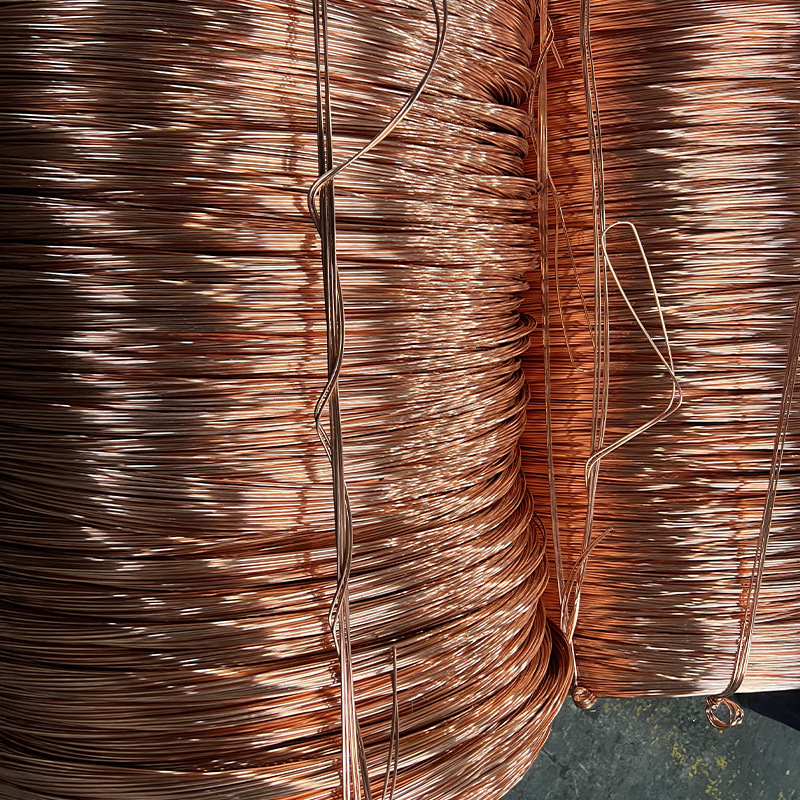| Name: | Pure Copper wire |
| Product name: | Pure Copper wire |
| Purity: | 99.95%-99.99% |
| Model Number: | C1100 C1220 |
| Diameter: | 0.01-15.0mm |
| Materials: | High Purity 99.9% Copper |
| Shape: | wire,rod |
| MOQ: | 5 Tons |
| Supply Ability: | 5000 Ton/Tons per Month |
| Price terms: | FOB, EXW, CIF, CFR |
| Payment terms: | 30% T/T as deposit + 70% balance before shippement |
| Inquiry |
Product Description
Red copper is simple copper. It is a tough, soft, ductile, purple-red and shiny metal. Because it has a rose red color and an oxide film is formed on the surface, it turns purple, so it is generally called red copper. It contains a certain amount of oxygen. Copper, therefore also known as oxygen-containing copper. Red copper is industrial pure copper, with a melting point of 1083°C, no allotropic transformation, and a relative density of 8.9, five times that of magnesium. The mass of the same volume is about 15% heavier than ordinary steel. Red copper has good weldability and can be made into various semi-finished products and finished products through cold and hot plastic processing.
Copper is named after its purple-red color. It is not necessarily pure copper. Sometimes a small amount of deoxidizing elements or other elements are added to improve the material and performance,
so it is also classified as a copper alloy. China's red copper processing materials can be divided into: ordinary red copper (T1, T2, T3, T4), oxygen-free copper (TU1, TU2 and high-purity, vacuum oxygen-free copper),
deoxidized copper (TUP, TUMn), adding a small amount of alloy There are four types of special copper elements (arsenic copper, tellurium copper, and silver copper).
The electrical conductivity and thermal conductivity of red copper are second only to silver, and it is widely used in making electrical and thermal conductive equipment.
Copper has good corrosion resistance in the atmosphere, seawater, certain non-oxidizing acids (hydrochloric acid, dilute sulfuric acid), alkali, salt solutions and various organic acids (acetic acid, citric acid).
Commonly used copper alloys are divided into three categories: brass, bronze, and white copper.
Pure copper is a purple-red metal, commonly known as "purple copper", "red copper" or "red copper".
The classification or quality of copper based on its purity and composition. Different grades of copper are used for various applications, and they are typically distinguished by their chemical composition,
impurity levels, and physical properties. The most common grades of copper include:
Copper Grades Based on Purity:
Electrolytic Tough Pitch (ETP) Copper (C11000): This is the most common type of copper, known for its high purity (99.90% minimum copper content).
ETP copper is widely used in electrical applications, such as wiring and electrical conductors.
Oxygen-Free Copper (OFC): OFC has an extremely low oxygen content, typically less than 0.001%. This makes it suitable for applications where high electrical conductivity is critical,
such as in high-performance audio equipment and certain electronic components.
Copper Alloy Grades:
Copper Alloys: Copper is often alloyed with other elements to enhance specific properties. Common copper alloys include:
Brass (Copper-Zinc Alloys): Various brass grades exist, with different proportions of copper and zinc. Brass is known for its corrosion resistance and attractive appearance,
making it suitable for decorative applications and fittings.
Bronze (Copper-Tin Alloys): Bronze contains copper and tin, and sometimes other elements. It is valued for its strength, corrosion resistance, and historical significance.
Bronze is often used in sculptures, bearings, and marine applications.
Related Products






 Send Email
Send Email +86-17691203929
+86-17691203929